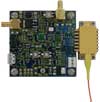

|
Highlights from the July 2013 issue of Photonics Spectra
|


|
Lasers Help Shrink and Sharpen Medical Devices
Advances such as shorter pulse widths and the ability to select pulse shape are enabling the fabrication of smaller, more precise lifesaving devices. In medical devices, smaller is often better – after all, implantable electronics, stents and other pieces of equipment can go into more places within the body if they are less intrusive. Other important device attributes are capability, cost and reliability. The last characteristic is vital because of how medical devices are used.
|
|
|
|

Fiber Optics Growing Strong for Biomedicine
Several company representatives weigh in on new trends in medical device manufacturing. Fiber optics allow medical devices to direct light to hard-to-reach areas for diagnostics and treatment – that’s hardly news. The first glass rod device for use as a surgical lamp was patented in 1898. But that doesn’t mean that the field isn’t growing: As new imaging and therapeutic methods are born, and as “smaller, cheaper, less invasive” remains the mantra of the biomedical industry, fiber continues to expand in the market.
|
|
|
|

Early Compliance Saves Money
Medical devices must pass strict regulations before they are released for clinical use, and policies vary depending upon where in the world the device is to be marketed. In some countries, navigating the system is so tricky that some companies are beginning to fight back. But wherever you are, the advice is always the same: Start thinking about compliance early.
|
|
|
|

Scanning White-Light Interferometry Fingerprints the Polishing Process
Characterizing the effects of polishing optical surfaces beyond a surface roughness parameter may enable superior finishes. A wide variety of techniques can be used to manufacture high-quality optical surfaces. These range from surface generation, grinding, lapping and full-aperture pitch polishing to more advanced techniques such as deterministic figuring using MRF (magnetorheological finishing), ion beam figuring and computer-controlled polishing. Specialized processes such as diamond turning and polishing are also used for some applications.
|
|
|
|

Novel Fibers Use Space to Extend Capacity Limits
Multicore, multimode and hollow-core optical fibers are helping engineers devise next-generation systems. The optical network that enables today’s smartphones, tablets and computers to stream all that beloved bandwidth is headed for trouble: In a decade or less, most experts say, transmission rates of current fiber networks will face a “capacity crunch” as single-mode fiber approaches its intrinsic capacity limit.
|
|
|
|


|
|
 |
|



|
T165 Laser Pulser
Highland Technology, Inc.
The T165 Laser Pulser incorporates an edge triggered pulse generator with 150 picoseconds nominal rise and fall times into a butterfly packaged laser. The 2" by 2" design connects directly to Type 1, 0.1" pin-pitch, butterfly laser packages, making it ideal for OEM use in laser systems.
More info >>
|
|
 |

|
Raman Spectrometer System
tec5USA, Inc.
Tec5USA Inc. has introduced a Raman spectrometer system for process control. Based on the established MultiSpec spectrometer system, the new cassettes contain a laser light source and a high-resolution spectrometer. A fiber optic Raman probe completes the measurement setup.
More info >>
|
|
 |

|
Epoxy Gel
Master Bond Inc.
Master Bond’s Super Gel 9, an optically clear, two-component urethane-modified epoxy gel, offers dimensional stability, softness and resilience for applications including the encapsulation of sensitive electronic parts and the sealing of optical components.
More info >>
|
|
 |

|
Xenon Source
Ocean Optics, Inc.
The HPX-2000-HP-DUV xenon light source from Ocean Optics is a 75-W short-arc lamp for UV-VIS absorbance spectroscopy and other applications where a high-intensity lamp is required. It provides continuous spectral output from 185 to 2000 nm and offers up to 2000 h of bulb life.
More info >>
|
|
 |


WEBINAR


|
Expert Briefings
In-depth presentations and interactive Q&As featuring top industry experts
2013 Webinars Available on Demand
 Topics include:
Topics include:
Laser Transmitters for Fiber Optic Communications
Techniques in Biophotonic Imaging
Enabling Technology for Highly Aspheric Optics Manufacturing
Industrial Imaging and Vision
Developments in Optics and Optical Components
Raman Spectroscopy for Research and Industry
|
|
|

|

|


Follow Photonics Media on Facebook and Twitter
|
 

|
|

sponsor
 |

sponsor
 |


sponsor
.jpg) |

sponsor
 |


sponsor
 |

|